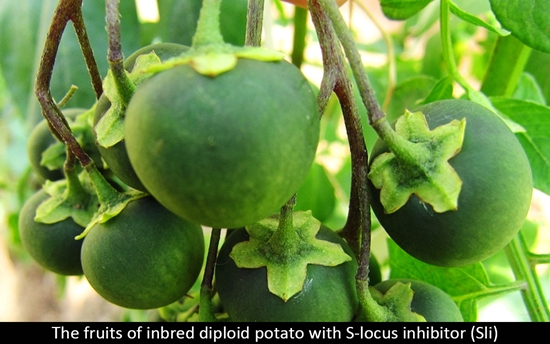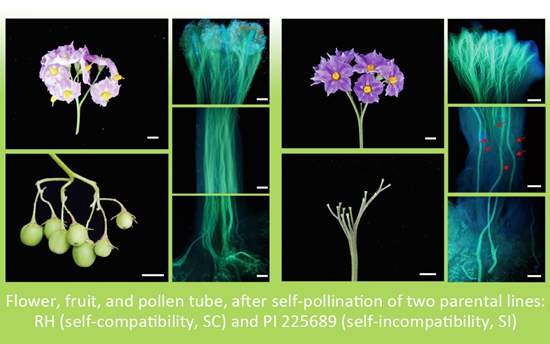A Universal Key to Solve Self-incompatiblity of Potatoes
The potato is the third most important staple food crop consumed by approximately 1.3 billion people. A major challenge appears in terms of expanding the potato’s contribution to feeding the fast-growing global population, especially under the threat of climate change.
Currently, most potato cultivars are tetraploids, carrying four copies of chromosome sets, thereby complicating breeding efforts to introduce new traits. Altering the potato to diploid plant could potentially solve this complexity. However, majority of diploid potatoes are self-incompatible with problem of inbreeding depression.
Researchers from the Agricultural Genomics Institute at Shenzhen, Chinese Academy of Agricultural Sciences (AGIS, CAAS) have worked on the development of a hybrid potato breeding system for years. A hybrid potato breeding system, aimed at converting the potato from a tuber-propagated tetraploid crop into a seed-propagated diploid crop through crossing inbred lines, is crucial to address challenges associated with global food security.
Dr. Huang Sanwen’s lab at AGIS, with Yunnan Normal University, discovered a self-compatible diploid potato, RH89-039-16 (RH), which can efficiently induce a mating transition from self-incompatibility to self-compatibility.
The self-incompatibility (SI) system is gametophytic and controlled by a single polymorphic locus, called S- locus. This locus encodes two types of determinants: female/pistil S-determinant (a cytotoxic S-ribonuclease, S-RNase) and male/pollen S-determinant (a set of pollen-specific S-locus F-box proteins, SLFs). The S-RNase inhibits the growth of self-pollen tubes by either degrading ribosomal RNA (rRNA) or disrupting the dynamic equilibrium of the cytoskeleton.
In this study, scientists identified a non-S-locus F-box (NSF) gene in RH. This gene is identical to the Sli gene (S-locus inhibitor), and capable of interacting with multiple allelic variants of S-RNases, functioning like a general S-locus inhibitor to introduce SC to both RH and other self-incompatible lines. The discovery of Sli offers a new and effective path for the hybrid diploid potato breeding program.
Discovery of Sli now offers a path forward for the diploid hybrid breeding program. Since Sli interacts not only with the self S-RNase in RH, but also with multiple types of the S-RNases to promote out-crossing with other diploids, the appearance of Sli may represent an efficient route to introduce a fixed SC phenotype to S-RNase-based self-incompatible plants.
Based on this study, a two-step model in Solanaceae was proposed to explain the evolution of new SLFs to confer SC to self-incompatible plants, by first interacting with the self S-RNase. Then, the reverse from SC to SI is induced by the loss of ability for these new SLFs to interact with the self S-RNase. The appearance of Sli at the non-S-locus region represents a new strategy, in addition to the loss-of-function (LOF) mutations of S-RNases, to confer SC to self-incompatible lines.
Ma Ling, Zhang Chunzhi, Zhang Bo contributed to this work equally as the co-first authors of the paper. This work was supported by grants from the National Natural Science Foundation of China (32002032 and 31972433), Yunnan Science Fund (202005AE160015 and 2019FJ004 to Y.S.), Shenzhen Science and Technology Program (KQTD2016113010482651 to S.H.), and special funds for Science Technology Innovation and Industrial Development of Shenzhen Dapeng New District (RC201901-05 to S.H.). This work was also supported by Yunnan Provincial and Shenzhen Municipal Governments.
Link to the paper:
https://www.nature.com/articles/s41467-021-24266-7


By Qiao Yang (qiaoyang@caas.cn)
-
 Apr 18, 2024Opening Ceremony of the Training Workshop on Wheat Head Scab Resistance Breeding and Pest Control in Africa Held in CAAS
Apr 18, 2024Opening Ceremony of the Training Workshop on Wheat Head Scab Resistance Breeding and Pest Control in Africa Held in CAAS -
 Apr 03, 2024IPPCAAS Co-organized the Training Workshop on Management and Application of Biopesticides in Nepal
Apr 03, 2024IPPCAAS Co-organized the Training Workshop on Management and Application of Biopesticides in Nepal -
 Mar 28, 2024Delegation from the School of Agriculture and Food Science of University College Dublin, Ireland Visit to IAS, CAAS
Mar 28, 2024Delegation from the School of Agriculture and Food Science of University College Dublin, Ireland Visit to IAS, CAAS -
 Mar 25, 2024Director of World Food Prize Foundation visited GSCAAS
Mar 25, 2024Director of World Food Prize Foundation visited GSCAAS -
 Mar 20, 2024Institute of Crop Sciences (ICS) and Syngenta Group Global Seeds Advance Collaborative Research in the Seed Industry
Mar 20, 2024Institute of Crop Sciences (ICS) and Syngenta Group Global Seeds Advance Collaborative Research in the Seed Industry
